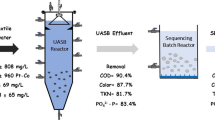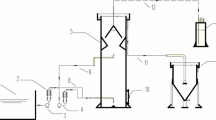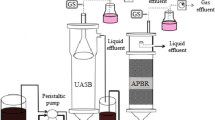Abstract
The operating performance of a single and two (in series) laboratory upflow anaerobic sludge-bed (UASB) reactors (2.7-L working volume, recycle ratio varied from 1:1 to 1:18) treating diluted wine vinasse was investigated under psychrophilic conditions (4–10°C). For a single UASB reactor seeded with granular sludge, the average organic loading rates (OLRs) applied were 4.7, 3.7, and 1.7 g of chemical oxygen demand (COD)/(L·d) (hydraulic retention times [HRTs] were about 1 d) at 9–11, 6 to 7, and 4 to 5°C, respectively. The average total COD removal for preacidified vinasse wastewater was about 60% for all the temperature regimes tested. For two UASB reactors in series, the average total COD removal for treatment of non-preacidified wastewater exceeded 70% (the average OLRs for a whole system were 2.2, 1.8, and 1.3 g of COD/[L·d] under HRTs of 2 d at 10, 7, and 4°C, respectively). In situ determinations of kinetic sludge characteristics (apparent V m and K m ) revealed the existence of substantial mass transfer limitations for the soluble substrates inside the reactor sludge bed. Therefore, application of higher recycle ratios is essential for enhancement of UASB pretreatment under psychrophilic conditions. The produced anaerobic effluents were shown to be efficiently posttreated aerobically: final effluent COD concentrations were about 0.1 g/L. Successful operation of the UASB reactors at quite low temperatures (4–10°C) opens some perspectives for application of high-rate anaerobic pretreatment at ambient temperatures.
Similar content being viewed by others
References
Kalyuzhnyi, S. V., Gladchenko, M. A., Sklyar, V. I., Kurakova, O. V., and Shcherbakov, S. S. (2000), Environ. Technol. 21, 919–925.
Kalyuzhnyi, S. V., Sklyar, V. I., Davlyatshina, M. A., Parshina, S. N., Simankova, M. V., Kostrikina, N. A., and Nozhevnikova, A. N. (1996), Bioresour. Technol. 55, 47–54.
Lurie, Y. Y. (1984), Analytical Chemistry of Industrial Wastewater, Khimiya, Moscow.
APHA. (1985), Standard Methods of the Examination of Water and Wastewater, 15th ed., American Health Association, Washington, DC.
Rebac, S., Gerbens, S., Lens, P., van Lier, J. B., Stams, A. J. M., Keesman, K. J., and Lettinga, G. (1999), Bioresour. Technol. 69, 241–248.
Rebac, S. (1998), PhD thesis, Wageningen Agricultural University, The Netherlands.
Kato, M. T., Rebac, S., and Lettinga G. (1999), Appl. Biochem. Biotechnol. 76, 15–32.
De Man, A. W. A., van der Last, A. R. M., and Lettinga, G. (1988), in Proceedings of the Fifth International Symposium on Anaerobic Digestion, Hall, E. R. and Hobson, P. N., eds., Pergamon, Oxford, England, pp. 197–209.
Vavilin, V. A., Vasiliev, V. B., and Rytov, S. V. (1990), Modeling of Destruction of Organic Matter by Microbial Community, Nauka, Moscow.
De Bazua, C. D., Cabrero, M. A., and Poggi, H. M. (1991), Bioresour. Technol. 35, 87–93.
Author information
Authors and Affiliations
Corresponding author
Rights and permissions
About this article
Cite this article
Kalyuzhnyi, S.V., Gladchenko, M.A., Sklyar, V.I. et al. One- and two-stage upflow anaerobic sludge-bed reactor pretreatment of winery wastewater at 4–10°C. Appl Biochem Biotechnol 90, 107–124 (2001). https://doi.org/10.1385/ABAB:90:2:107
Received:
Revised:
Accepted:
Issue Date:
DOI: https://doi.org/10.1385/ABAB:90:2:107




